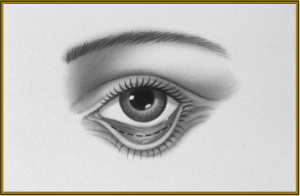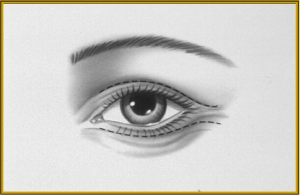“Blepharoplasty” or eyelid “lift” is a cosmetic plastic surgery operation to change the appearance of the eyes. Blepharoplasty does this by reducing loose skin, removing fatty bulges and and tightening the muscles around the eye.
Many different factors attribute to ageing around the eyes such as genetics, sun exposure and lifestyle factors.
There are two types of eyelid lift surgeries which can be performed together or separately if there is only a single concern:
- Upper Eyelid Surgery: Corrects heavy upper lids and loose skin draping over the upper eyelashes, as well as reducing bulging pockets of fat. In severe cases progressive hooding of the skin can also impair vision, making it a medical consideration.
- Lower Eyelid Surgery: Corrects protruding fat deposits and excess skin under the eyes.
Eyelid surgery is often combined with other facial surgeries, such as a facelift or brow lift, to achieve more comprehensive facial changes. These various options can be discussed in a consultation with Dr Robert Knight — our experienced facial plastic surgeon
Meet your Surgeon

Dr Robert Knight
Meet your Surgeon
Dr Robert Knight FRACS:
- Registered Specialist Plastic Surgeon
- AHPRA MED0001198549
Education and Training:
- Attended medical school in South Africa, and trained at the internationally renowned Baragwanath Hospital
- Awarded a Cyanamid Pharmaceutical Scholarship, the Medical Students Council Award and the Graham Wilkinson Medal
- Member of the Royal College of Surgeons of Edinburgh
- Awarded the LGI cardiothoracic prize and presented at several conferences in London, Stockholm and Cologne
FAQ
How can this procedure help me?
Blepharoplasty modifies the appearance of the eye area. The extent of surgery will vary depending on whether an Upper, Lower or Combined blepharoplasty occurs. Benefits of Blepharoplasty include:
- Improved vision where overlying sagging skin is impairing vision
- Modified appearance of the eye area
- Reduction in wrinkles around the eye area
The Consultation Process: What to Expect
A consultation with Dr Robert Knight, our facial plastic surgeon, is the first step when you are considering surgery and will take approximately 45 minutes. You should frankly discuss your goals after surgery. You should always keep in mind that the desired result is improvement, not perfection.
During the consultation, your surgeon will ask you a variety of questions covering everything from your current health situation to details about the physical outcomes you desire. Be prepared to talk about current medications, allergies and any past or current medical treatments.
You will receive a detailed and thorough examination of your eyes and how they relate to your face as a whole. Based on your history and examination, your options for eyelid surgery are determined and will be discussed with you.
The recovery process and any potential complications that could arise will also be discussed. At any time, you are encouraged to ask any questions that you may have.
The Procedure: What Does it Involve?
In upper eyelid surgery:
A strip of skin in the upper eyelids is removed, sometimes also with a small amount of muscle and fat to tighten the upper eyelid. Fine stitches are used to close the incision, which lies along a skin crease line.
In lower eyelid surgery:

Transconjunctal Method: Where excess fat is the sole problem. An incision is made on the inside of the lower eyelid, leaving no external scar
Open Method: Where there is excess fat and skin. The incision is made along the lower eyelid lashes and muscle and skin of the lower eyelid are tightened. Excess skin and fat is removed. Scarring is along an existing skin crease.
Will I need to be hospitalised for the procedure?
Upper eyelid surgery is a “day surgery” and takes around one hour to perform. You will be able to go home within a few hours of your procedure.
Lower eyelid lift may require an overnight hospital stay. All surgeries are performed in fully accredited facilities ensuring your safety.
Can Blepharoplasty be combined with any other procedures?
Yes. It is common to combine blepharoplasty with a facelift or browlift.
What is recovery like?
Advancements in anaesthesia over recent years has meant more comfort for patients – less pain with minimal post operative sedation and nausea and a quick recovery to “feeling normal.” The anaesthetists in our team are highly skilled and experienced in modern techniques and devoted to keeping you comfortable.
Naturally you may feel “woozy” as the anaesthetic wears off. You may feel some soreness, swelling or discomfort, but this is quite natural. You may also feel tired after surgery, but this and the soreness is normal and will last only a short while.
Immediately after your operation, you will be sitting up and the eyes will have cold packs resting on them, to reduce bruising and swelling.
If external incisions are made, fine stitches are used to close these. These are removed about 5 days after surgery. If the trans-conjunctival approach is used, there are no stitches to be removed.
The eyelids have a protective lubricating role for your eyes. After surgery while the eyelids are swollen, this function is compromised and so for a few weeks it will be necessary for you to lubricate your eyes regularly with ointment or drops.
Results: What and When?
Bruising and swelling varies from person to person – it is maximal in the first three days and usually settles over seven to fourteen days.
Scarring will gradually fade over time.
When can I resume day-to-day activities?
You should feel ready to resume your normal routine within a week or two, although exercise should not be undertaken for at least several weeks after surgery. However, you are required to follow all post-operative instructions until all healing has taken place.
What complications can arise from the procedure?
As with any surgical procedure, there are potential risks and complications. These include:
- Infection
- Bruising, bleeding, haematoma formation
- Scarring
- Anaesthetic problems, including Deep Vein thrombosis
- Allergy
- Pain
Risks and complications specific to Blepharoplasty include:
- Excessive skin removal leading to exposure of cornea
- Asymmetry of eyelids
- Prolonged dryness, itchiness or watering of the eye
- Temporary or permanent changes in vision
The potential risks and complications of the surgery will be discussed with you in detail at your preoperative consultations.

Will this procedure leave scars?
Dr Knight carefully makes all incisions in areas that will be well concealed in your eyelid structure and skin creases. If the Transconjunctal Method is used for Lower Eyelid Surgery, no scar will be left.
What else should I consider before having this surgery?
Emotional stability is the primary factor to be considered before any aesthetic surgery is performed. It is mostly your mental attitude and realistic expectations that determines a successful outcome.
Before deciding to have this procedure, you may want to consider your planning for the healing period. Will you need help or assistance from others? Also if you do encounter complications, it is a good idea to understand how they are typically handled so that you are fully prepared.
Any more questions?
Please feel free to contact us with any additional questions that you might have about this procedure. Our team will be happy to address any concerns that you may have.
Before & After
To protect the privacy of our patients, eyelid lift (blepharoplasty) before and after cases can be seen in our office during your consultation.




